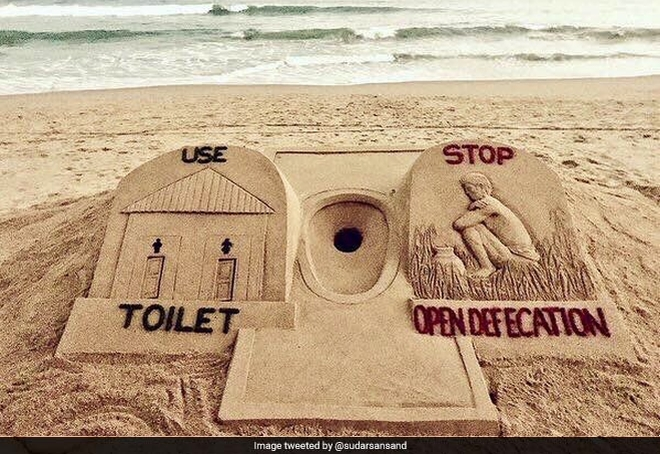Description

Copyright infringement is not intended
Context: Country has crossed the milestone of 50,000 ODF Plus villages under Swachh Bharat Mission (Gramin).
Details
- India has crossed a milestone of 50 thousand open defecation-free (ODF) Plus villages.
- The top performing States are Telangana with 13 thousand 960 ODF Plus villages followed by Tamil Nadu and Madhya Pradesh.
About Open Defecation
- Open defecation is the human practice of defecating outside ("in the open") rather than using a toilet.
- People may choose fields, bushes, forests, ditches, streets, canals, or other open spaces for defecation.
- They do so either because they do not have a toilet readily accessible or due to traditional cultural practices.
- The practice is common where sanitation infrastructure and services are not available.
- Even if toilets are available, behaviour change efforts may still be needed to promote the use of toilets.
- Open defecation can pollute the environment and cause health problems and diseases.
- High levels of open defecation are linked to high child mortality, poor nutrition, poverty, and large disparities between rich and poor.
About open defecation-free (ODF) plus villages
- 'Open defecation free' (ODF) is a term used to describe communities that have shifted to using toilets instead of open defecation.
- Ending open defecation is an indicator being used to measure progress towards the Sustainable Development Goal Number 6 "Ensure availability and sustainable management of water and sanitation for all."
- Extreme poverty and lack of sanitation are statistically linked. Therefore, eliminating open defecation is thought to be an important part of the effort to eliminate poverty.
- ODF plus village is defined as “a village which sustains its Open Defecation Free (ODF) status, ensures solid and liquid waste management and is visually clean.”
- This includes ensuring that all households in a village, as well as the Primary School, Panchayat Ghar and Anganwadi Centre, have access to a toilet and that all public places and at least 80% of households effectively manage their solid and liquid waste and have a minimal litter and minimal stagnant water
- Swachh Bharat Mission Gramin Phase-II was launched in February 2020 with the aim to ensure that all villages in the country can declare themselves as ODF Plus by the end of 2024.
- The mission towards becoming ODF Plus has several components including biodegradable waste management including the GOBARdhan Scheme, Grey water management, Plastic waste management and faecal sludge management.
- ODF Plus villages have been divided into three categories;
- This has created a healthy, competitive spirit, resulting in people participation for accelerated implementation of sustaining complete swachhata (Cleanliness).
Swachh Bharat Mission
- Swachh Bharat Mission (SBM) is a country-wide campaign initiated by the Government of India in 2014 to eliminate open defecation and improve solid waste management.
- It is a restructured version of the Nirmal Bharat Abhiyan launched in 2009.
- Phase 1 of the Swachh Bharat Mission lasted till October 2019.
- Phase 2 is being implemented between 2020–21 and 2024–25.
- The mission aimed to achieve an "open-defecation free" (ODF) India by 2 October 2019, the 150th anniversary of the birth of Mahatma Gandhi through construction of toilets.
- The objectives of the first phase of the mission:
- Eradication of manual scavenging.
- Generating awareness and bringing about behaviour change regarding sanitation practices.
- Building capacity at the local level.
- The second phase of the mission aims to sustain the open defecation free status and improve the management of solid and liquid waste, while also working to improve the lives of sanitation workers.
- Under the scheme, the Government provides subsidies for constructing toilets, waste management structures, and awareness campaigns to bring behaviour change.
- The campaign is financed by the Government of India and state governments.
- The mission is split into two: Rural and Urban.
- In rural areas "SBM - Gramin" is financed and monitored through the Ministry of Jal Shakti.
- In Urban areas "SBM - urban" is overseen by the Ministry of Housing and Urban Affairs.
Present Status
- According to the dashboards maintained by ministries, more than 100 million individual household level toilets have been constructed in rural areas, and 6 million household toilets in urban areas.
- Nearly 6 million community and public toilets have also been constructed in the urban areas.
- Nearly 11 crore online Integrated Management Information System (IMIS) have been constructed in the country.
- Nearly 2 lakh Community Sanitary Complexes (CSCs) have been constructed under the programme.
- More than 4,200 cities and more than 600,000 villages across the country have declared themselves open defecation free (ODF).
- More than 87 thousand wards in urban areas now have 100% door to door collection of solid waste and nearly 65 thousand words practice 100% segregation of waste at source.
- According to UNICEF, the number of people without a toilet has been reduced from 550 million to 50 million.
- The World Bank reports that 96% of Indians who have a toilet use it.
https://newsonair.gov.in/News?title=India-crosses-milestone-of-50%2c000-ODF-Plus-villages&id=437968













